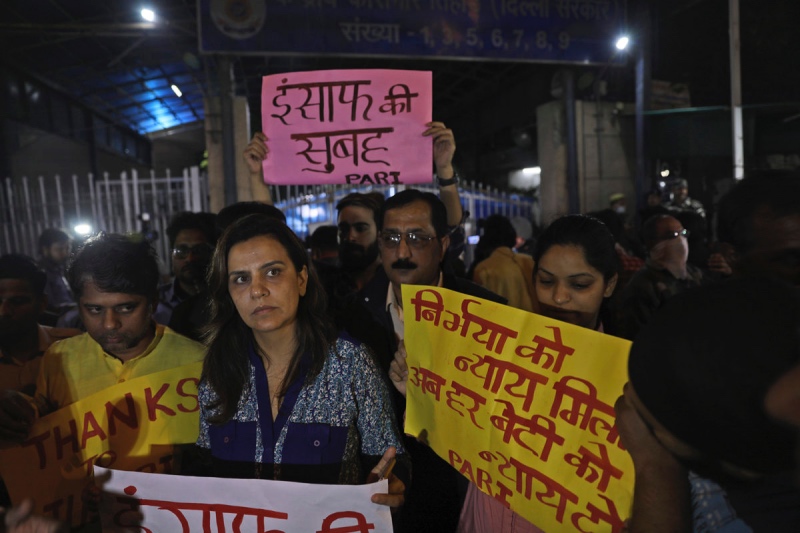
SATPAL SINGH, a professor at the Jacobs School of Medicine and Biomedical Sciences at the University at Buffalo in the US, says it’s time to face the reality that violence against women “is not an aberration but a commonplace occurrence in world society”…
Via RNS
A gruesome chapter in Indian life closed on 20th March when four of the six perpetrators of a 2012 gang rape were executed in New Delhi. The Indian press hailed the executions as bringing long-awaited “closure” to the life of a tormented family and a nation frustrated that the penalty came seven years after the horrific crime.
The victim’s mother, who watched her daughter die from injuries suffered in the attack, said, “I hugged my daughter’s photograph and told her we finally got justice.”

Indians hold banners and rally outside Tihar central prison, where four men were sentenced to capital punishment in New Delhi, on 20th March. Four men sentenced to death for the gang rape and murder of a woman on a New Delhi bus in 2012 were hanged Friday, concluding a case that exposed the scope of sexual violence against women in India and prompted horrified Indians to demand swift justice. Banners in local language read “Dawn of Justice” and “Nirbhaya got justice, now every daughter will get justice too.” PICTURE: AP Photo/Manish Swarup.
“To begin to end this sickness, we must recognise and accept that women have not been created subservient to men. That they are not properties of men to be plundered by them at their will. That brutalising women is not a part of a ‘normal’ way of life, whether it is domestic violence, sexual assault, honour killing, trafficking, female infanticide or the burning of wives alive on the altar of dowry.”
But does this closure mean anything in the larger universe of violence against women, a problem that the World Health Organization has labelled a “global public health problem of epidemic proportions”? As we are cooped up in our houses against the wrath of COVID-19, it’s worth taking a moment to address another pandemic of staggering proportions.
According to a United Nations report, more than 50,000 women are killed each year by intimate partners and family members. Even these dire numbers pale, however, when we consider the broader web of violent mistreatment of women. According to rigorous analysis by the WHO, 35 per cent of all women in the world are subjected to physical and/or sexual violence in their lifetime. This amounts to more than a billion women. That figure doesn’t account for the estimated 23 million selective abortions of female fetuses since 1970, nor those millions of women who suffer traumatic brain injury from domestic violence.
If we want to address this serious cancer that has metastasised to all aspects of our society, we have to face the reality that these numbers suggest: Violence against women is not an aberration but a commonplace occurrence in world society.
In her documentary about the Indian rape case, India’s Daughter, British filmmaker Leslee Udwin interviewed some of the rapists and their lawyers. “The horrifying details of the rape had led me to expect deranged monsters,” she said. “Psychopaths. The truth was far more chilling. These were ordinary, apparently normal and certainly unremarkable men.”
Udwin goes on to caution against thinking that capital punishment serves the purpose of justice. “For me the truth couldn’t be further from this — and perhaps their hanging will even mask the real problem, which is that these men are not the disease, they are the symptoms.”
As is clear from reports by the WHO, the UN and other agencies, this underlying disease is an integral part of “normal” life, and not just in India. The disease has infected the very soul of humanity.
To begin to end this sickness, we must recognise and accept that women have not been created subservient to men. That they are not properties of men to be plundered by them at their will. That brutalising women is not a part of a “normal” way of life, whether it is domestic violence, sexual assault, honour killing, trafficking, female infanticide or the burning of wives alive on the altar of dowry.
Such a sweeping, but absolutely critical, change in societal attitude can’t be achieved by any one segment of society. It needs a collaborative effort from leaders in education, legislation, law enforcement, human rights, politics and, not least, religion. Admittedly, such a momentous change will not come overnight. The culture of mistreatment of women dates back to, and has been ingrained in our psyche, for not only centuries but for millennia.
We can take solace in the response of large number of Indians to the case, as many around the world have been encouraged by the more recent prosecutions of Harvey Weinstein and Larry Nassar, and in the story of Nadia Murad. Admittedly, these are only microsteps toward the goal of complete equality between men and women. But every microstep in the right direction is a step toward the ultimate goal.
Indeed, the rising number of protests raising awareness about violence against women gives me hope that we are on the cusp of a revolution, the pace of which will pick up speed as younger generations become more active in challenging the nightmare under which half of our own species has been living for thousands of years.
It’s my hope, 244 years after the Declaration of Independence declared that all men are created equal, that we are on the verge of realising the self-evident truth that all men and women are created equal as well.
Satpal Singh is a professor at the Jacobs School of Medicine and Biomedical Sciences at the University at Buffalo in the US.





